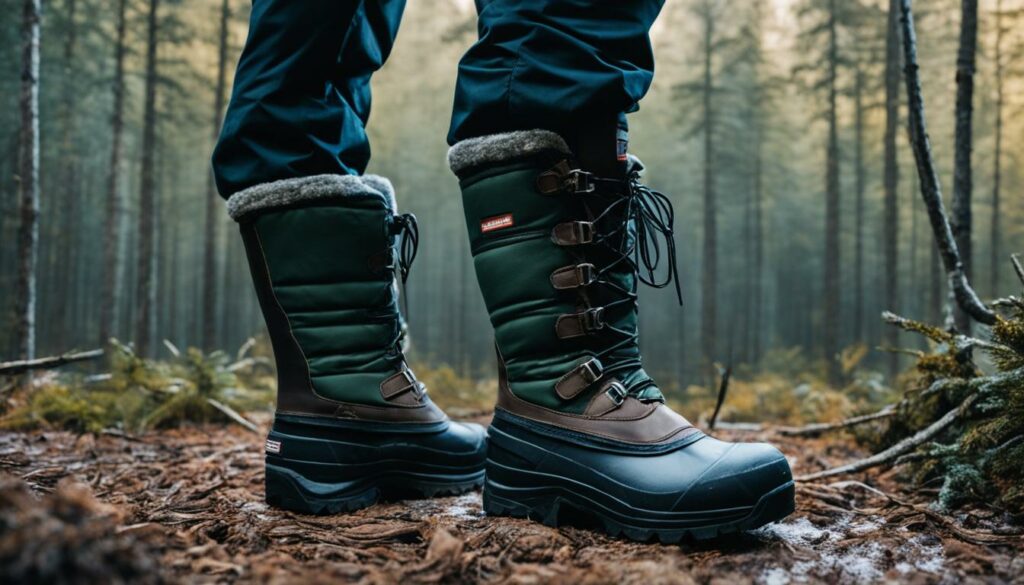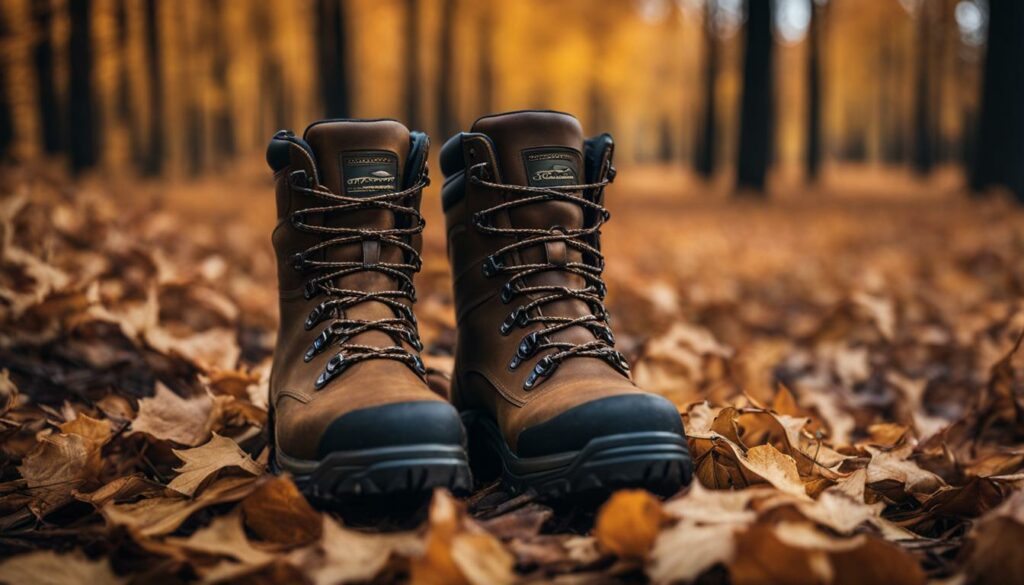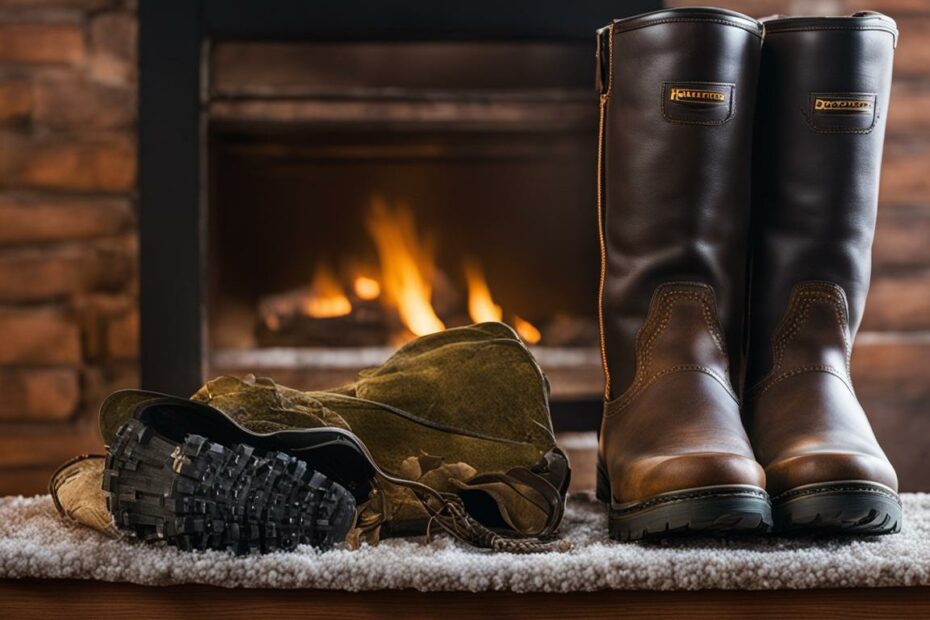When heading out for a hunting trip in cold weather, one of the most important factors to consider is keeping your feet warm. Cold feet can be uncomfortable and distract you from your hunting experience.
Follow these expert tips and use the right gear for cold hunting conditions to ensure toasty toes and maximize comfort.
The Importance of Moisture Control for Warm Feet
Moisture control is critical to keeping feet warm while hunting. Proper moisture management helps prevent discomfort and the potential for cold-related injuries. One effective way to control moisture is to wear moisture-wicking fabric next to your skin.
Fabric Worn Next to Skin
The fabric you wear next to your skin plays a significant role in moisture control. Opt for moisture-wicking materials like silk, synthetic, or thin wool liner socks. These fabrics draw moisture away from your skin, keeping it dry and reducing the risk of cold-induced injuries.
For example, silk liner socks are lightweight and breathable. They efficiently absorb moisture, making them an excellent choice for moisture control.
Similarly, synthetic liner socks offer effective moisture-wicking properties and are often more durable than silk. Thin wool liner socks, on the other hand, provide both moisture control and insulation, keeping your feet warm in colder hunting conditions.
Another way to combat moisture is using a small amount of foot powder. Foot powder can absorb excess moisture, reducing the chances of blisters, athlete’s foot, and other discomforts caused by damp conditions.
Comparison of Moisture-Wicking Fabric
| Material | Moisture-Wicking Properties | Insulation | Recommended Conditions |
|---|---|---|---|
| Silk | Excellent | Lightweight | Moderate to cold temperatures |
| Synthetic | Effective | Durable | Moderate to cold temperatures |
| Thin Wool | Good | Insulating | Colder temperatures |
| Merino Wool | Excellent | Highly insulating | Extreme cold temperatures |
Protecting Your Feet with Air Gaps
Insulating your feet with air gaps between layers is crucial to keeping them warm during hunting trips. By creating air pockets, you can effectively trap heat and reduce the loss of warmth from your feet.
Here are some key strategies to insulate your feet with air gaps:
Start with a Thin Base Sock
Begin by wearing a thin base sock that fits snugly but not tight. This serves as the first layer of insulation and helps in moisture control. Choose a sock made from moisture-wicking materials like merino wool or synthetic blends. These socks will help keep your feet dry and prevent moisture buildup, which can lead to cold feet.
Layer on an Insulating Sock
Over the base sock, layer on an insulating sock to provide warmth. Insulating socks are typically thicker and have better moisture-wicking properties. They act as a buffer between the base sock and your hunting boots, creating air gaps that retain heat. Look for socks specifically designed for insulation, such as those made with high-quality wool or synthetic insulation.
Consider Battery-Operated Heated Socks
Battery-operated heated socks can be a game-changer if you hunt in icy conditions or have susceptible feet. These socks feature built-in heating elements that provide continuous warmth to your feet. They offer precise temperature control and ensure your feet stay warm throughout your hunting expedition.
Size Up When Layering
When layering socks, it’s important to size up your hunting boots to accommodate the additional bulk. A tight-fitting boot can compress the layers, eliminating the air gaps and reducing the insulation. Opt for a slightly larger size to ensure proper airflow and maximize warmth.
Look for Socks with Toe Box Material Mapping
Socks with toe box material mapping provide added reinforcement and insulation to the most vulnerable part of your foot – the toes. These socks have strategically placed padding or thicker material in the toe box area to enhance warmth and protect against cold spots. Consider investing in socks specifically designed for hunting that incorporate this feature.

Choosing the Right Hunting Boots
The choice of hunting boots is crucial for keeping your feet warm during your hunting expeditions. Selecting the appropriate boots can make a significant difference in your overall comfort and protection, allowing you to focus on the thrill of the hunt.
Rubber hunting boots may not be the best option for frigid temperatures. While they offer durability and waterproof capabilities, they lack insulation, making them unsuitable for keeping feet warm in cold conditions.
Additionally, rubber boots’ lack of breathability can lead to excessive moisture buildup, making feet more susceptible to discomfort and frostbite.
Instead, consider investing in well-insulated pac boots or mountaineering boots that provide superior warmth and insulation. These boots are designed to withstand harsh weather conditions and are equipped with advanced insulation technologies to keep your feet cozy even in freezing temperatures.
Furthermore, it is essential to ensure a proper fit when choosing hunting boots. Avoid boots that are too tight, as they can restrict blood flow and impede the natural insulation properties of your feet. Opt for boots with enough room to accommodate thick socks without compromising circulation.
Regarding materials, synthetic boots are often preferred over leather for their breathability and moisture-wicking properties. Synthetic materials offer better moisture control, preventing sweat buildup and keeping your feet dry. However, high-quality leather boots can also provide insulation and durability.
Consider applying waterproofing treatments to the exterior of your hunting boots to enhance their waterproof capabilities. These treatments create an additional barrier against moisture, ensuring your feet remain dry and warm in wet hunting environments.
Gaiters can be a valuable accessory to pair with your hunting boots for added protection against moisture and debris. These protective coverings wrap around your boots and lower legs, shielding them from water, snow, and other external elements.
Comparison of Hunting Boot Options
| Boot Type | Insulation | Material | Waterproofing | Gaiters Compatibility |
|---|---|---|---|---|
| Rubber Boots | No insulation | Rubber | May offer waterproof capabilities | Compatible with gaiters |
| Well-Insulated Pac Boots | Thick insulation | Synthetic or leather | May require waterproof treatments | Compatible with gaiters |
| Mountaineering Boots | Advanced insulation | Synthetic or leather | May require waterproof treatments | Compatible with gaiters |

Exterior Insulation for Heat Retention
Limiting heat loss through conduction from the exterior is essential for keeping your feet warm while hunting. You can effectively maintain heat and enhance your comfort in cold conditions by incorporating various exterior insulation methods.
Well-Built Insoles
One exterior insulation method is adding well-built insoles to your hunting boots. These insoles provide an additional insulation layer, reducing heat loss through conduction. Look for insoles specifically designed for cold weather activities to ensure maximum warmth.
Boot Muffs
Another option to retain heat is to use boot muffs. Boot muffs are similar to sleeping bags for your boots, covering them completely and providing insulation against the cold. They effectively trap heat and prevent it from escaping, keeping your feet warmer for longer.
Toe Box Sleeve
An innovative solution for limiting heat loss through conduction is to create a toe box sleeve made from old winter socks. This sleeve acts as a barrier, protecting your toes from the cold metal of the boots that can conduct heat away from your feet. Cut off the toe section of an old winter sock and slip it over your toes before putting on your hunting boots.
Combining Various Methods
To achieve optimal warmth, consider combining multiple methods of exterior insulation. For example, you can use well-built insoles with boot muffs and a toe box sleeve for maximum heat retention. By layering these insulation methods, you create multiple barriers that minimize heat loss and maximize insulation.
| Methods of Exterior Insulation | Benefits |
|---|---|
| Well-Built Insoles | – Additional insulation – Reduces heat loss through conduction |
| Boot Muffs | – Covers the entire boot – Traps heat to keep feet warmer |
| Toe Box Sleeve | – Creates a protective barrier – Prevents heat loss through conduction |
| Combining Various Methods | – Maximizes heat retention – Provides optimal warmth |
Tips and Tricks for Warm Feet
When it comes to keeping your feet warm while hunting, a few additional tips and tricks can make a big difference. By implementing these strategies, you can ensure maximum warmth and comfort during your hunting expeditions. Here are some key tips to consider:
- Sweat Management: Managing sweat is crucial to prevent moisture buildup and keep your feet dry. Start by wearing light socks during the hike to minimize sweat production. When you reach your hunting stand, change to insulating socks to provide warmth and moisture-wicking properties.
- Proper Sock Materials: Choosing the right sock materials is essential for warmth and comfort. Opt for wool, polypropylene, or silk socks, as they have excellent moisture-wicking properties and provide insulation.
- Getting the Right Boot Size: Ensuring the correct boot size is crucial for trapping warmth and allowing proper blood circulation in your feet. Ensure your boots have enough air space to create a layer of insulation.
- Timing Toe Warmer Activation: If you’re using toe warmers, timing their activation is essential for optimal performance. Activate them before putting on your boots to ensure they’re warm and ready to provide heat.
- Using Carpet or Foam Rubber on Stand Floor: Insulating the floor of your hunting stand can make a significant difference in keeping your feet warm. Consider using carpet or foam rubber to provide insulation and prevent heat loss.
- Keeping Feet Moving: It’s essential to keep your feet moving and engage in small exercises while sitting in the stand. This helps improve blood circulation and generates heat, keeping your feet warm even in cold conditions.
Conclusion
Ensuring warm and comfortable feet is crucial for a successful hunting experience. By implementing the right gear and following optimal practices, hunters can keep their feet warm even in the coldest conditions.
Choosing the appropriate hunting boots and socks is the first step. Insulated pac boots or mountaineering boots are ideal for cold temperatures while moisture-wicking synthetic or wool liner socks help control moisture. Layering with insulating socks and using well-built insoles can create air gaps for added insulation.
Managing sweat, changing socks when necessary, and selecting the right materials can prevent moisture buildup and improve insulation. Proper boot size is also essential for sufficient air space. Timing toe warmer activation, external insulation methods like boot muffs, and keeping feet moving during the sit can further enhance warmth.
